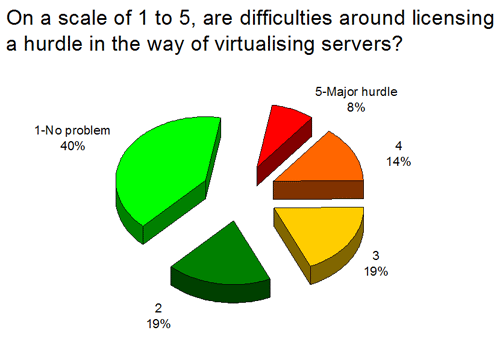This article is more than 1 year old
Licensing in virtual systems still making us ill
Confusion reigns in the world of the blind
Lab We know from extensive research carried out with readers of The Register that in the server arena, virtualisation is moving into the mainstream.
We are also beginning to see interest in utilising some form of virtualisation for the delivery of desktop services, although the level of activity is currently far lower than that with x86 servers. Organisations that have embarked on extensive virtualisation projects are now reporting that routine management is becoming a major challenge.
One aspect of management that has not yet received much media attention, but which can cause operational pain concerns the impact of software licensing in virtual systems. Indeed, the licensing of software, everything from the operating system through the middleware to the applications as well as any management and security agents required, is already a cause for concern for IT managers in virtualised operations. And with nearly one in three organisations already reporting that the proliferation of virtual machines is causing headaches, the licensing challenge is likely to grow rapidly.
But the management of software licensing in business has always posed challenges for those responsible for IT operations. Right from day one of computing many software vendors and resellers have managed to create a licensing battlefield with users often feeling pressured, even when they are doing nothing wrong. Indeed, even before the advent of x86 virtualisation, the software industry managed to make software licensing very difficult to administer, through the huge variety of licensing terms from different vendors, unintelligible without the intervention of a pack of lawyers or the application of a huge amount of time reading very, very small print.
The ease with which virtual machines can be created and deployed is adding another layer of complexity to the fog, and the potential risk exposure for organisations cannot be overstated. A quick glance at the figure below highlights that more than 20 percent of organisations see licensing as a major challenge to their use of virtualised x86 server systems. As the deployment of virtual desktops attracts attention and as more organisations increase the use of x86 virtual servers to support mainstream business applications software license management will grow in importance.

Whilst over 20 percent do see difficulties in licensing for their virtualised environments, it is fair to note that almost twice as many have no problems at all. One reason why so many have reported no problems with software licensing could be that these are organisations either using open source software, more specifically those operating without a formal, and hence paid for support service or subscription, or those with enterprise wide licenses that permit unrestricted use. Given that server virtualisation is yet to become the dominant method of service delivery it could also be the case that those without challenges have yet to scale up enough to run into the issues proper.
One potential tool to help ease the pain is software asset management, an underexploited tool in the armoury of IT managers. It can, as a minimum, help ensure that license conditions are not broken. When operated efficiently it can also help to ensure that licenses are used optimally and that excess expenditure is avoided whilst drastically reducing the risks of inadvertently breaching software licensing conditions.
Using some form of software asset management does hold benefits but does not address a significant problem identified by many end users, namely that current licensing models are not suited to use in virtualised operations. There are a variety of licensing models available, some based on the physical host devices, some by the size / resources of the physical server, by the number of concurrent or named users and yet others by the individual virtual machine. The potential for confusion is immense.
It might be suggested that open source could help – but we know some vendors require that all physical kit in a virtualised environment be placed on a support or subscription service even if only a relatively small number of machines are used in critical operations that demand such support. Clearly, using open source software in important business systems does not mean that licensing, and especially support and subscription, terms do not need careful consideration: in truth all vendors, open source or otherwise, are struggling with moving to payment models that don’t take the physical world into account.
Overall, previous feedback from readers of The Register has told us that people are not happy with the license models available today, virtualised or otherwise. We would very much like to hear from you about how you want to see software licensed for use in virtual systems. What models look good to you? Have you run into any problems in this area? How do you manage software licenses without breaking the bank? Please give us your feedback below.
